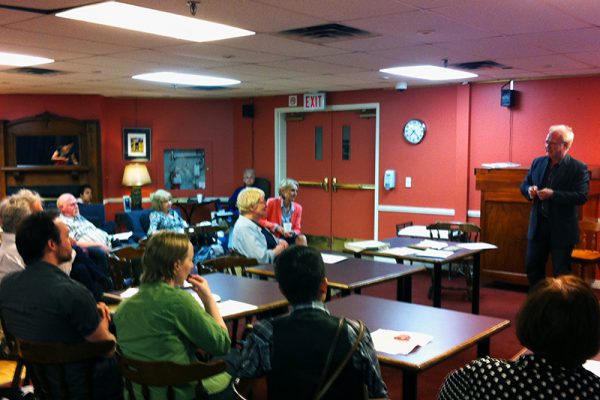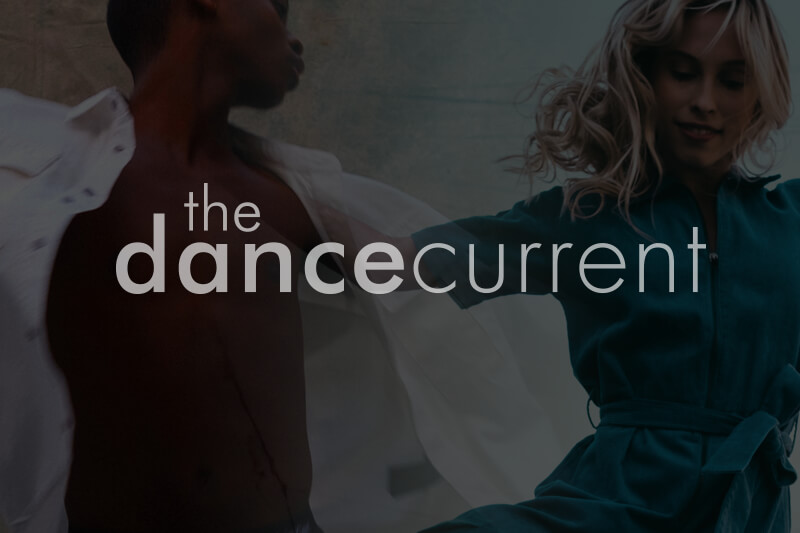Somewhere toward the end of dance Immersion, this writer had an epiphany. No matter how stirring the traditional African drumming and dancing, or how stylish a tap routine, or how attractive the synchronization of energetic b-girls, or how charming the Caribbean folklore, it was the contemporary choreography that gave substance to the evening.
Ten years ago, choreographer Vivine Scarlett began the dance Immersion Showcase Presentation to provide performance opportunities for artists of the African Diaspora. With each new incarnation, the concert has become more polished, with the 2005 dance Immersion being the most satisfying to date. The showcase has broadened its scope to include black dance artists in a wide range of dance genres, producing a concert that is as rich in diversity as it is in age range. In fact, this dance Immersion was one of the best, all-round dance evenings of the Toronto season, yet its audience draw remained lacklustre, which takes me back to my first point.
In contrast to the “entertainment” aspects of certain forms, the more oblique contemporary choreography requires the audience to exercise its collective brain. On a program mixing entertainment-based work with more thought provoking material, the latter becomes a stumbling block for some audience members and leads to the “inaccessible” label. On the other hand, by its very nature, an evening presumed to be contemporary dance is going to attract a small audience. One that is also stamped as “ethnic” is going to be lethal in terms of the usual contemporary dance patrons (unless, of course, its Alvin Ailey American Dance Theatre). In a related matter, the number of black audience members at dance Immersion tends to be proportionately and disappointingly small.
One wonders, therefore, how dance Immersion should bill itself, caught as it schizophrenically is between the more accessible aspects of entertainment forms on one side, and the more challenging aspects of contemporary forms on the other. The audience that responded enthusiastically to drumming, tap and hip-hop, was respectful of contemporary dance. Thus Scarlett walks a fine line. She could probably pack her house by giving more sway to the entertaining forms of dance, but being true to her mandate, she keeps a judicious measure of contemporary dance on her program. Her problem, therefore, remains – how does she fight against the wider prejudice against contemporary dance among the public at large? By including break dance, for example, Scarlett opens up dance Immersion’s doors; by including contemporary dance, she perhaps contradicts that intention.
Scarlett has grown into a savvy programmer over the years as she walks her razor’s edge between mass and limited appeal. For example, she placed contemporary dance in the interior of the concert. The best piece on the program was Ghislaine Doté’s “L’âmentation”, but the Montréal choreographer had to cede pride of place to the urban dance troupe RUKUS, chosen as the closer.
The title of Doté’s piece is a clever play on the words l’âme (soul) and lamentation (mourning), and is about the suffering brought about by disastrous love affairs. The prelude to the work takes the form of three short pieces, a “lamenting” solo, followed by two duets, one between a man and a woman, and the other, two women. Doté’s movement is one of full-bodied, explosive energy mixed with almost violent contact improv that uses weight bearing for physical effect. She also has a very inventive gestural language that she employs when the rest of the body is still. Thus, the solo dance was like a coiled spring of tension performed to the ragged, spoken text of “Don’t let me fall”, while the duets careened between combat and tenderness. In the male/female duet, for example, the woman took turns literally diving into the man’s arms, or picking him up to hurtle him through the air. The two women were more caressing which made their conflict more poignant.
The three short, connected works could certainly have stood together as “L’âmentation”, but Doté’s coup de théâtre was yet to come. The finale had her six masterful dancers (Jenny Brizzard, Julie Burrel, Mohamed N’Diaye, Virginie Leclerc, Aboubakar Mané and Doté herself) come to the edge of the stage where, in a line, they launched into a sequence of breathtaking body abuse. In a ritual for modern times, they stamped, clapped, jumped and slapped themselves in an intricate rhythm of collective thunder that was as mesmerizing as it was compelling. How the dancers learned the closely choreographed routine and kept the count is a marvel, as was Doté’s contemporary spin on African ritual. Sometimes one or two would try to break away into their own rhythm pattern, but were always brought back into the frantic physicality of the group. Surprisingly, “L’âmentation” ended with a whimper, as six exhausted individuals repeated the gentle face caresses of the female duet, and retreated into solitary, lyrical movement. African-born Doté, who was raised in the Ivory Coast, is clearly a gifted choreographer whose career bears careful watching.
Toronto’s Jennifer Dahl had an impressive duet in her enigmatic “Carve” which she performed with Ray Hogg. Garbed in an old-fashioned dress and suit, the two followed parallel and symmetrical pathways that seemed to evoke both the past and present of a relationship. The fragmented movement was light, gentle, lyrical and unhurried, yet determined, assured, even calculated, with a jazz potpourri for a musical background. The duet “carved” space as Dahl and Hogg negotiated the twists and turns of an extended journey over the stage that had stylistic allusions to ballet, modern, jazz, lindy, ballroom, Latin, Broadway and African dance. When they repeated movements, they created tantalizing and resonating echoes within the dynamics of their oblique relationship. Were they old-time, concert dance performers? This thought came to mind as they went through their demanding dance routine. The couple never looked at each other, however, nor directly at the audience, as they executed their perpetual motion machine. Even more fascinating was the degree of menace that existed in the seeming simplicity of the movement. Only once did Hogg look at the audience, and the only contact between the two was the finale when Dahl clutched at Hogg’s hand.
New-York based Germaul Yusef Barnes, late of the legendary Bill T. Jones/Arnie Zane Dance Company, brought the American body-beautiful aesthetic to the concert. Muscular, supple, and magnificently controlled, Barnes’ movement seemed effortless in his solo “O to Mah”, set to a seductive, Latin fusion blues song by Ledisi with lyrics that spoke of being “orange” and “blue”, or the ups and downs of life. Barnes’ orange/blue costume captured this dichotomy, as did his horizontal/vertical choreography. The piece was an homage to his single mother and the spiritual and emotional journey she undertook to make a better life for her children, but this sentiment was at odds with the masculine Barnes and the bluesy/blowsy nature of the song. Nonetheless, Barnes would look good dancing to a reading of the telephone book, and while his ballet-based vocabulary and jazz dance influences were not particularly original, his sexy muscle isolations were eye candy enough to engage the audience. Barnes may have been inspired by a noble sentiment, but the piece worked better as a tongue-in-cheek satire on the states of being blue and orange.
Tap was represented by the very clever Shawn Byfield and his Urban Sole Tap Company (David Cox and Shaun Israel). The routine of these three talented and personality-to-the-max young men included the de rigueur, eye-catching, riffing one-upmanship, but Byfield gilded the lily by including avant-garde, improvised music by a live band and rap lyrics from both Sean Mauricette and Ufallani Jones. The latter young woman had a delicious moment with the men as she challenged them with her rap “Tap to Me” that goaded them on with reference to great tappers of the past, and gave the piece its name. Mauricette added humour with his vocal imitation of tap sounds. In short, Byfield and Co. impressed with the polish of the act and the skill of the performers.
Children are an absolute certainty to engage an audience and the youngsters of NGOMA Drum and Dance Ensemble are no exception. With the adult Scarlett assisting choreographically, and the adult Yvonne Francis helping musically, the ten young performers won the hearts of the audience with their “Drum Jam”, a collage of West African rhythms and dance rituals. Particularly winsome was the drum/dance one-on-one dialogue.
Byron Beckford’s colourful Caribbean Folk Performers were up to their usual form with “Cultural Renaissance”. Featuring nine dancers (eight women and Beckford) and eight drummers (all men), the delight of this ensemble is both their various shapes and sizes, as well as their slick and attractive presentation. No wonder the group is a mainstay of Afro-Caribbean and roots festivals all over North America.
Finally, the attractive nine young women of RUKUS, with choreography by Diana Webly and the crew itself, showed they could take on the b-boys with their own well-crafted, self-titled “RUKUS”. Although the costumes were identical, white tops and jeans, each performer individualized the look, which added to the charm of the troupe. My one cavil is performance ethos. While the young women excelled at showy urban dance tricks, their facial expressions and body language were not quite up to professional standards. One was actually chewing gum, while several seemed to be sleep-walking through the routine rather than “being on” and “performing”.
In short, Scarlett should be congratulated on the enjoyable program she put together. More to the point, dance Immersion certainly deserves a greater audience, both from inside and outside the dance community, and that it brought Doté to town was the icing on the cake.
Comments:
I just want to thank Paula Citron for the words she wrote about my piece (“L’amentation”). My dancers and I were definitely encouraged by them. Besides, it truly was a savvy program for us as we were able to watch the other performers, and it was rich in variety and energy.
Cheers.
Ghislaine Dote,
Montréal, QC
Tagged: African, Performance, Tap, West African, ON , Toronto





